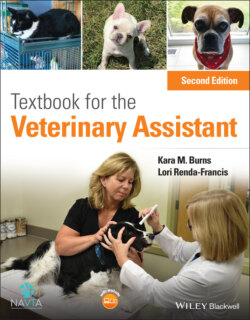Читать книгу Textbook for the Veterinary Assistant - Lori Renda-Francis - Страница 2
Table of Contents
Оглавление1 Cover
2 Title Page
3 Copyright Page
4 Dedication Page
5 Acknowledgments
6 About the Companion Website
7 Chapter 1: Introduction to the Veterinary (or Assistant) Profession Ethics References
8 Chapter 2: Medical Terminology Medical terms Prefixes Suffixes Root words Common abbreviations used in veterinary medicine References
9 Chapter 3: Anatomy Anatomical directional terms Skeletal system Branches of science Body systems External anatomy Common veins Muscles Internal organs Urogenital system Internal structures of the thorax Conclusion References
10 Chapter 4: Behavior, Handling, and Restraint Social behavior Animal body language Fear Free® Identification Avian restraint Reptile restraint Rabbit restraint Handling rodents References
11 Chapter 5: Office Procedures and Telephone Techniques Telephone techniques Office procedures References
12 Chapter 6: Nutrition Overview Proteins Carbohydrates Fats Vitamins Minerals Water Palatability Recommendations Weight management Summary References
13 Chapter 7: Breeds Cat breeds Dog breeds References
14 Chapter 8: Breeding and Genetics Introduction Dogs Cats Determining gender in puppies and kittens Breeding management References
15 Chapter 9: General Nursing Care and Physical Exams Taking a history Physical exam Determining and recording vitals General nursing care Common diseases References
16 Chapter 10: Exam Room Procedures Recognizing ectoparasites Nail trimming Ear cleaning Eye medications Anal glands Bathing animals Administering oral medications Maintaining exam room equipment
17 Chapter 11: Immunology Innate immunity Acquired immunity Cell‐mediated immunity Vaccination References
18 Chapter 12: Laboratory Procedures Laboratory considerations Safety Equipment Quality control Sample collection References
19 Chapter 13: Pharmacology Drug classifications Storage and disposal of drugs References
20 Chapter 14: Radiology Radiology safety measures and guidelines Cleaning screens Labeling, filing, and storage of radiographs Radiographic positioning Processing Quality control Conclusion References
21 Chapter 15: Surgical Assisting The sterilization process Wrapping a surgical pack Cold sterilization Instruments Suture material and suture needles Gowns and Drapes The sterile field Preparing for surgery Opening and passing sterile items Preparing the patient Postsurgical procedures Surgical positioning Surgical monitoring Surgical log Surgical room conduct
22 Chapter 16: Avian, Exotics, and Rodents Avian Reptiles, Amphibians, and Fish Rabbits Guinea pigs Mice and rats Gerbils Hamsters Ferrets Hedgehogs Sugar gliders Chinchillas References Resources
23 Chapter 17: Equine Skeletal system Digestive tract Nutrition Behavior and handling Nursing care and husbandry of horses References
24 Chapter 18: Preparing for Internships and Employment Interview Resumé writing Cover letter References Resources
25 Chapter 19: Inventory What will be inventoried in your clinic or hospital? A well‐run pharmacy The want list The veterinary assistant’s role Drug inventory Human versus computer: both needed! Organizing inventory References
26 Chapter 20: Euthanasia and Pet Loss The five stages of grief References
27 Chapter 21: Client Management Evaluating your clients Client management; essential skills for the veterinary assistant Employee roles References
28 Chapter 22: Medical Records References
29 Chapter 23: Occupational Safety and Health Administration What is the Occupational Safety and Health Administration? Material safety data sheets OSHA labeling of secondary containers OSHA inspections Common OSHA veterinary violations Fines References
30 Chapter 24: Pet Health Insurance References Resources
31 Glossary
32 Index
33 End User License Agreement
